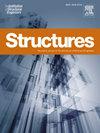方钢管-矩形钢板可替换耗能支撑抗震性能试验研究
IF 4.3
2区 工程技术
Q1 ENGINEERING, CIVIL
引用次数: 0
摘要
本文提出了一种新型的可替换耗能支撑(REDB),可以快速恢复建筑物的耗能能力,显著降低地震后的修复成本。REDB包括一个h型支撑、两个u型连接构件、一些方钢管和矩形钢板组合的可更换耗能构件和一些螺栓。通过准静力试验研究了某钢框架下部结构中5根redb的滞回性能。以可更换耗能部件的类型和数量作为实验参数。提出了三种不同矩形钢板的可更换耗能元件(a型、b型和c型)。结果表明,h型支撑基本为弹性支撑,耗能能力主要由可替换耗能构件提供。在3种不同的可替代耗能分量中,b型可替代耗能分量的滞回曲线最饱满。单耗能构件的延性约为双耗能构件的2倍。此外,提出了一种计算三种不同可替换耗能部件屈服能力的设计方法,并进行了验证。本文章由计算机程序翻译,如有差异,请以英文原文为准。
Experimental study on seismic behavior of replaceable energy dissipation braces with square steel tubes and rectangular steel plates
A novel replaceable energy-dissipation brace (REDB) was proposed in this paper, which was for rapidly recovering the energy dissipation capacity of a building and significantly reducing the repair cost after earthquakes. The REDB included a H-type brace, two U-shaped connection components, a few replaceable energy dissipation components combined with square steel tubes and rectangular steel plates, and some bolts. The hysteretic performance of five REDBs in a steel frame substructure was investigated through a quasi-static test. The type and the number of replaceable energy dissipation components were assumed as experimental parameters. Three types of replaceable energy dissipation components with different rectangular steel plates (A-type, B-type, and C-type) were proposed. It shown that the H-type braces were basically elastic, and the energy dissipation capacity was mainly offered by the replaceable energy dissipation components. Among the three different replaceable energy dissipation components, the hysteretic curves of B-type replaceable energy dissipation component were the fullest. The ductility of a REDB with single energy dissipation component was about twice of that of a REDB with double energy dissipation components. In addition, a design method for calculating the yield capacity of three different replaceable energy dissipation components were developed and verified.
求助全文
通过发布文献求助,成功后即可免费获取论文全文。
去求助
来源期刊

Structures
Engineering-Architecture
CiteScore
5.70
自引率
17.10%
发文量
1187
期刊介绍:
Structures aims to publish internationally-leading research across the full breadth of structural engineering. Papers for Structures are particularly welcome in which high-quality research will benefit from wide readership of academics and practitioners such that not only high citation rates but also tangible industrial-related pathways to impact are achieved.
 求助内容:
求助内容: 应助结果提醒方式:
应助结果提醒方式:


